
Hover flies are truly unsung heroes in the garden.
Operating like undercover agents, hover flies are easily mistaken for bees or wasps. When at rest on a flower, it’s nearly impossible to tell the difference.
When they take to the skies, however, hover flies are easy to identify because they levitate like little helicopters and dart among the blooms. They are one of the few insects that can fly backwards.
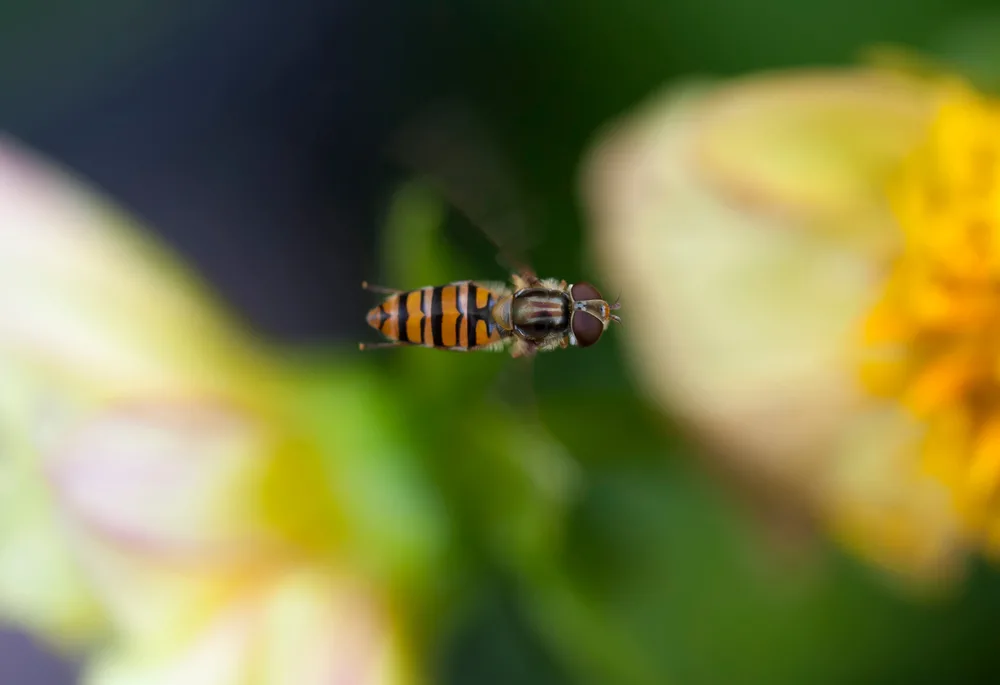
Despite the key role they play in pollination and insect predation, hover flies don’t receive near the same amount of love and adoration as bees and ladybugs do.
Let’s take a moment to appreciate hover flies as the helpful and abundant allies they are in the garden.
About Hover Flies…
With 6,000 species in 200 genera, hover flies – also known as flower flies or syrphid flies – are found in every continent except Antarctica.
In North America alone, there are hundreds of species – some smooth and slender, others furry and plump.
Many have bright yellow and black stripes, bands, or dots along their bodies, making them appear to be wasps or bees to the untrained eye. Some even make a loud buzzing sound.
But hover flies are “true flies” – they don’t sting or bite.
This fascinating bit of subterfuge, known as Batesian mimicry, allows a harmless species, like the hover fly, to deceive predators into identifying them as a more harmful one, like a stinging insect.
Many creatures – including us humans – are programmed to fear and avoid anything with black and yellow coloring.
Although adult hover flies much prefer flower nectar, during dry periods they are known to land on people to sip their salty sweat. This is why they’re also mistaken for sweat bees.
So next time you think you see a bee or wasp in the garden – or one lands on you as you’re working up a sweat – don’t freak out and take a closer look.
Count the wings. Hover flies have only two, while bees and wasps will have four.
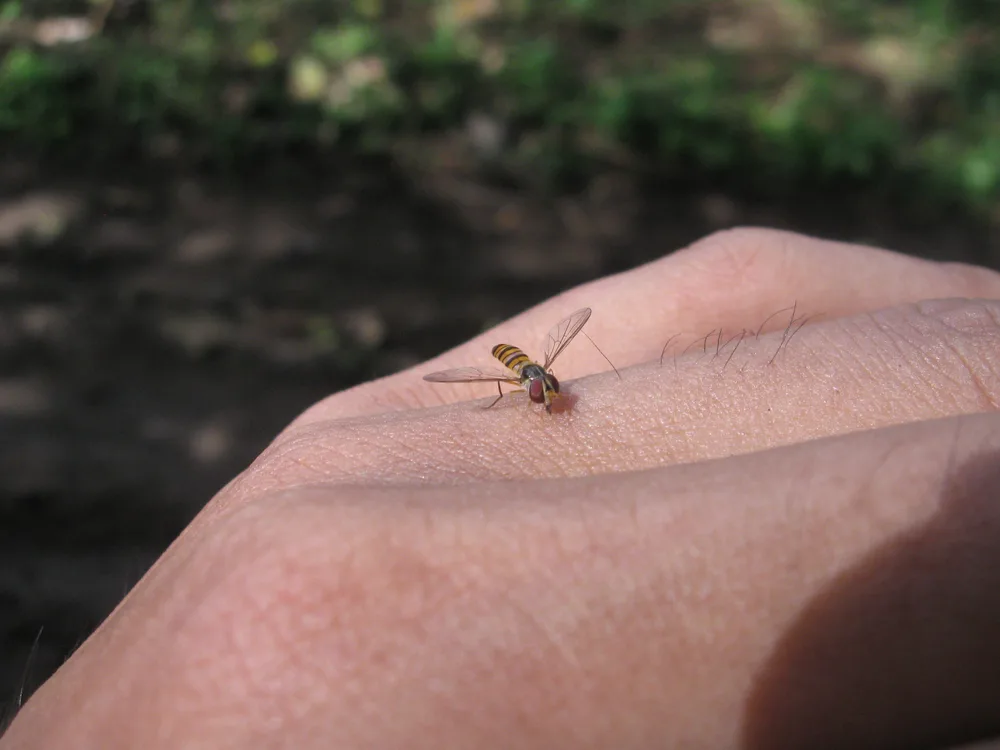
Look at its head. Hover flies have a typical fly head with enormous compound eyes. They also lack the long antennae that most bees and wasps have.
Once you can calmly (and correctly!) identify these beneficial tricksters, you’ll absolutely want to keep them hovering around your garden.
Hover flies are Excellent Pollinators
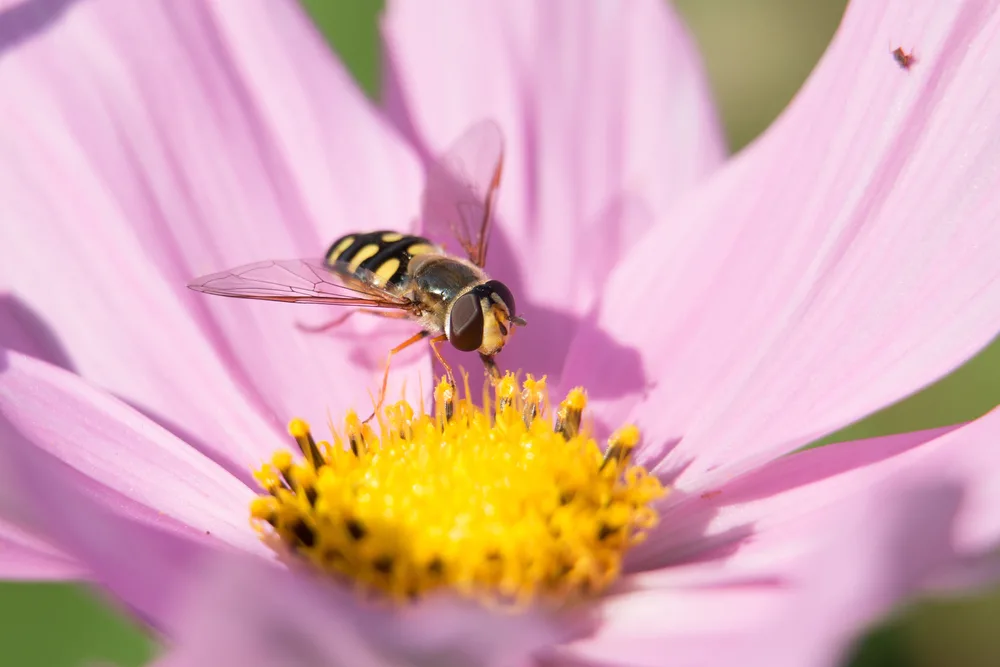
Adult hover flies are frequent visitors to a wide variety of plants, zipping from flower to flower in search of nectar and pollen.
Their characteristic flight pattern is one of exceptional maneuverability. When not suspending themselves in mid-air, hover flies can move up, down, forwards and backwards. They can abruptly change position by rotating in place.
Carrying pollen here, there and everywhere, hover flies are a vital link in plant reproduction, fruit set, and crop yields. They are second only to wild bees as pollinators, though bees often get the credit for the hover fly’s good work.
Hover flies also travel greater distances and move pollen across a wider geographical range. They are found in many regions that other pollinators don’t dare venture, in every biome except extreme desert and tundra.
And despite the tragic decline of pollinating insects the world over, hover flies fortunately don’t appear to have suffered the same fate. Hover flies have shown fairly stable populations over the past decade, migrating over long distances in the trillions, and cross-pollinating many billions of flowers along the way.
Hover Fly Larvae are Aphid-Eating Machines
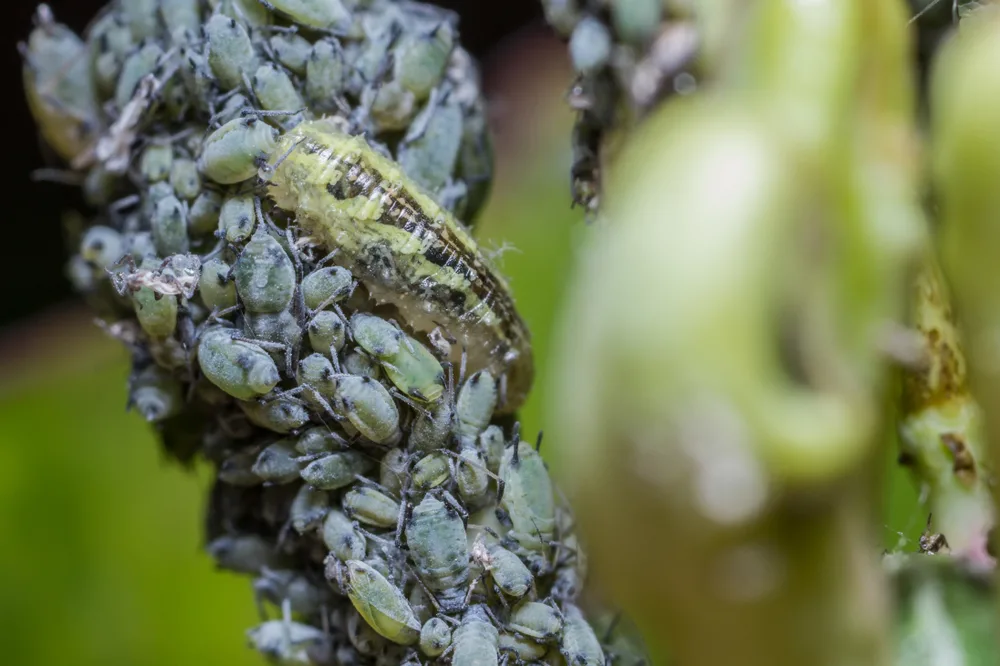
As adults busy themselves consuming nectar and pollen, hover fly larvae have an altogether different diet.
While some species feed on rotting wood and other organic matter, many kinds of hover fly larvae are insectivores with a voracious appetite for aphids, thrips, mites, scales, small caterpillars, and other soft-bodied garden pests.
Each adult female lays around 400 eggs on plant leaves, often near or among aphid colonies. The eggs are tiny and white, each about the size of a grain of rice.
Hatching in 2 to 3 days, the larvae look like small slugs with tapering towards the head. They may be brown, green, or creamy-white. Even though hover fly larvae are blind and legless, they move around the plant with ease in search of food.
The mouths are equipped with a three-pointed spear that impales its prey and sucks the insect dry, leaving behind a shriveled and blackened corpse.
A single hover fly larva can consume between 400 to 500 aphids during this 2 to 3 week period before pupating into adults.
Though the lifespan of a hover fly is fairly short – only spanning a few weeks – several generations will be hatched throughout the growing season.
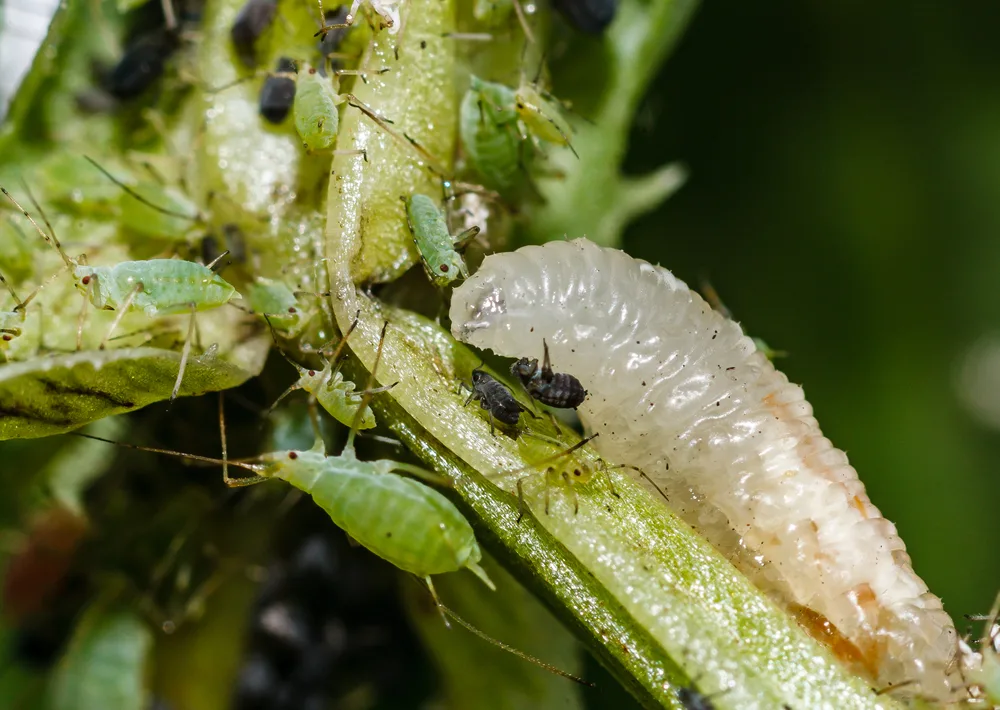
This works out be a whole lot of biological pest control. It is estimated that 1 billion predatory hover fly larvae will consume the equivalent of 3 trillion aphids in a year.
10 Native Plants to Attract Hover Flies to Your Garden
Encouraging hover flies to visit your lands isn’t much of a challenge since they feed on a long list of flowering plants.
Most broadly, hover flies enjoy members of the Asteraceae family – especially sunflowers, daisies, and asters. Hover flies are also fond of small-flowered herbs like dill, cilantro, and lavender.
Unlike bees that have a long, straw-like proboscis that can access and suck up the nectar from deep throated tubular flowers and other hard to reach places, most hover flies have much shorter mouthparts.
Akin to a stick with a sponge on the end, they mop up the sweet stuff by dabbing it around the flower head repeatedly.
The hover fly’s stubby tongue means that flat and open faced flowers are much easier for them to approach. They also tend to have a preference for white and yellow colored blooms.
Hover flies are active in spring all the way until autumn. To support them all season long it’s essential to provide a variety of plants that bloom at different times.
1. Lanceleaf Coreopsis (Coreopsis lanceolata)
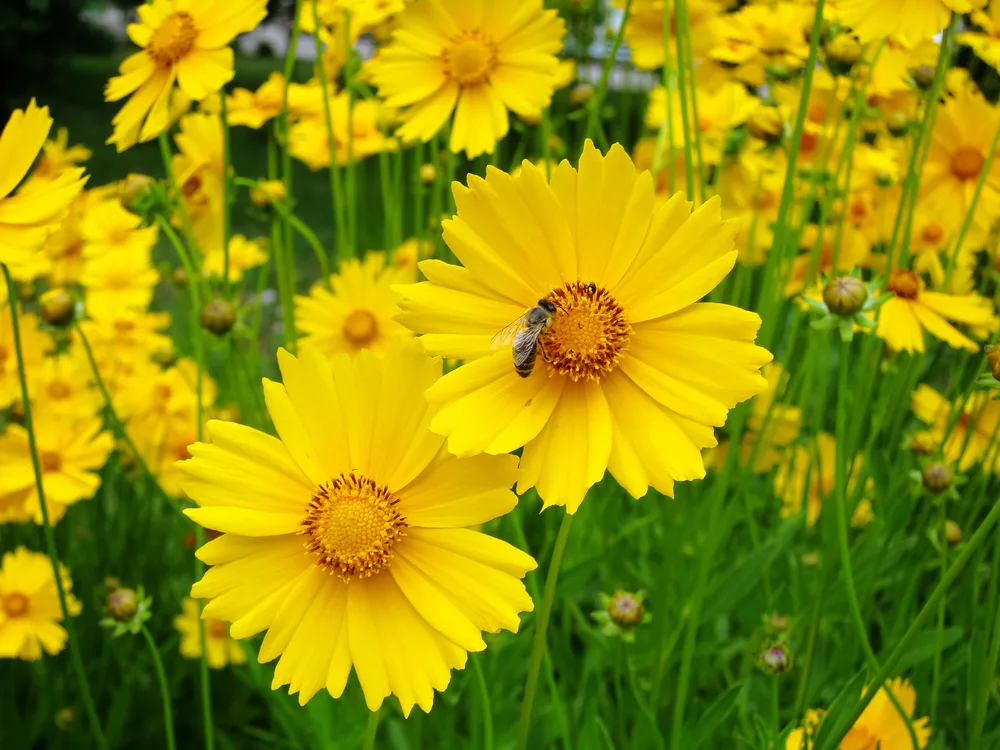
Lanceleaf coreopsis is a native wildflower with bright and cheery yellow blooms.
The daisy-like flowers are about 2-inches across with flat, toothy tipped petals and an open floral disk – the ideal landing zone for hover flies.
This nectar and pollen rich perennial will attract other wonderful pollinators as well.
Easy to grow, it thrives in any soil type and is tolerant of drought, heat, and high humidity. Simply deadhead spent flowers to encourage additional blooming and to keep its generous self-seeding in check.
Hardiness zone: 4 to 9
Sunlight exposure: Full sun
Bloom time: May to July
2. Purple Coneflower (Echinacea purpurea)
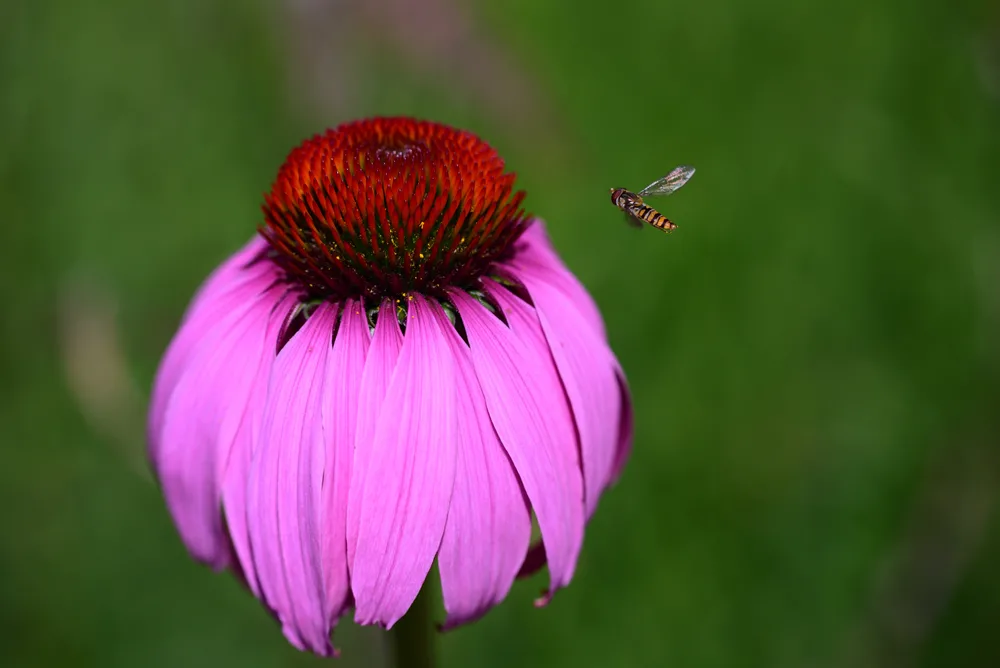
Coneflowers are easy to love – hardy, handsome, long blooming, and beloved by wildlife.
Purple coneflower is a classic in wildflower gardens. The flat purplish-pink petals surrounding the prominently domed flower head offers a prime perch for visiting hover flies, bees and butterflies.
Remove faded flowers to prompt rebloom, but leave a few on the plant so birds can enjoy their seeds in autumn.
Hardiness zone: 3 to 8
Sunlight exposure: Full sun to part shade
Bloom time: June to August
3. Meadowfoam (Limnanthes douglasii)
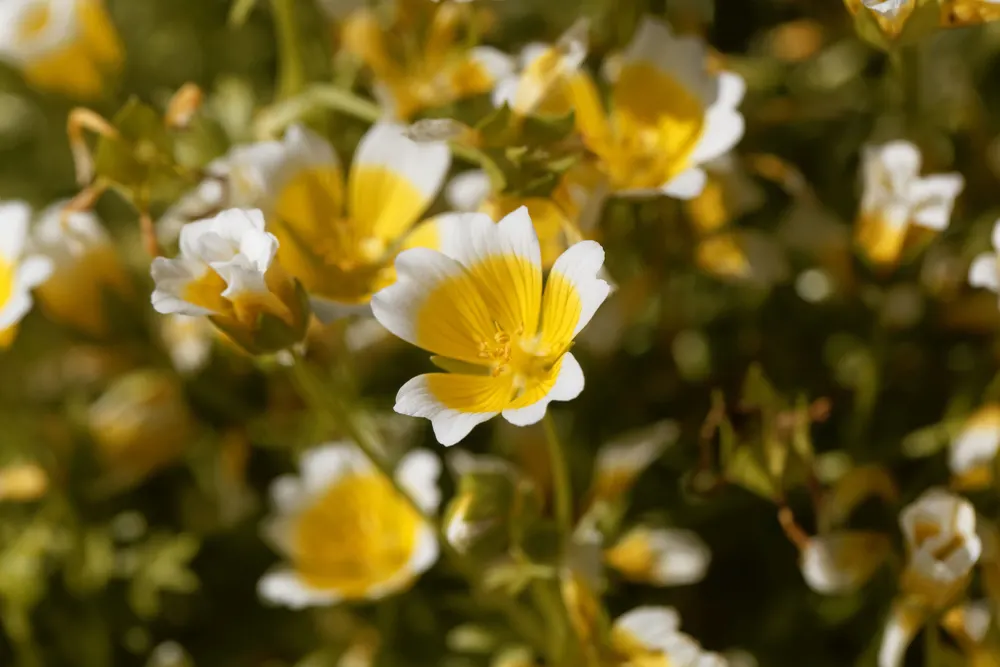
Meadowfoam is an adorable, ground hugging specimen that blossoms profusely with flowers that look like little eggs.
The 1-inch blooms have five petals with white tips and a perfectly round dab of yellow in the center. It’s also aptly known as poached egg plant.
Bountiful in nectar too, meadowfoam checks all of the hover fly’s boxes – it’s yellow and white, flat and open, and in bloom all summer long.
Although meadowfoam is frost tender, it will freely reseed itself and come back in greater numbers the following year.
Hardiness zone: 2 to 11
Sunlight exposure: Full sun
Bloom time: May to August
4. American Angelica (Angelica atropurpurea)
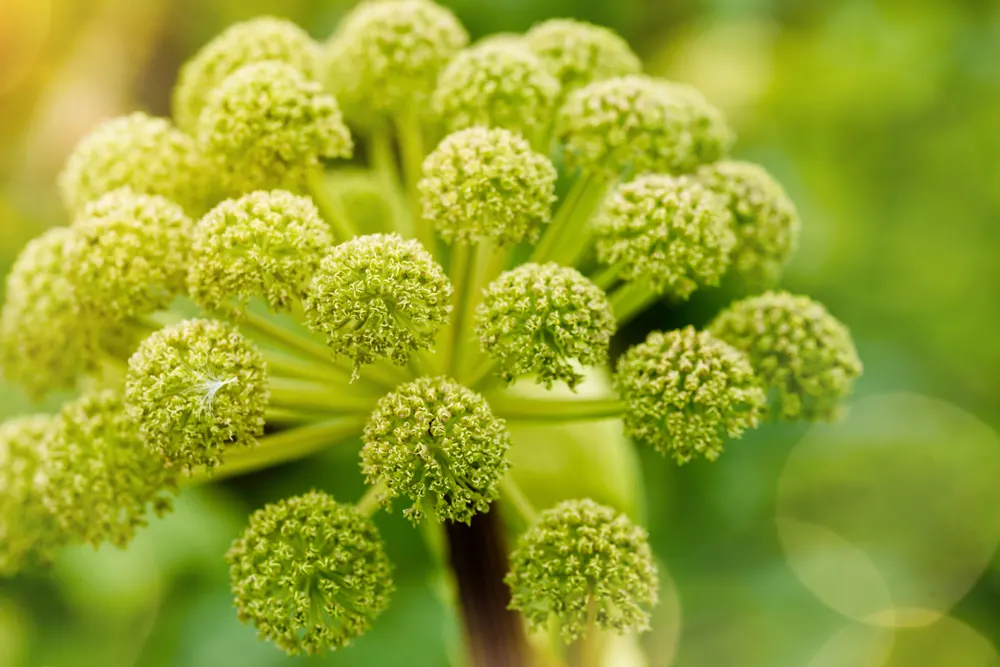
A gorgeous giant, American angelica bears 10-inch rounded umbels composed of tiny creamy-green flowers. The multi-branched orbs rest on striking deep purple stalks that can rise to heights as great as 10 feet.
American angelica is native to swampy woodlands and likes it moist. It will thrive in rain gardens, along waterways, and in marshy spots where it will always have wet feet.
Umbellifers like American angelica are also good hosts for beneficial insects. These huge blooms provide a proper perch for hover flies to happily feed.
Hardiness zone: 4 to 7
Sunlight exposure: Full sun to part shade
Bloom time: June to September
5. Maximilian Sunflower (Helianthus maximiliani)
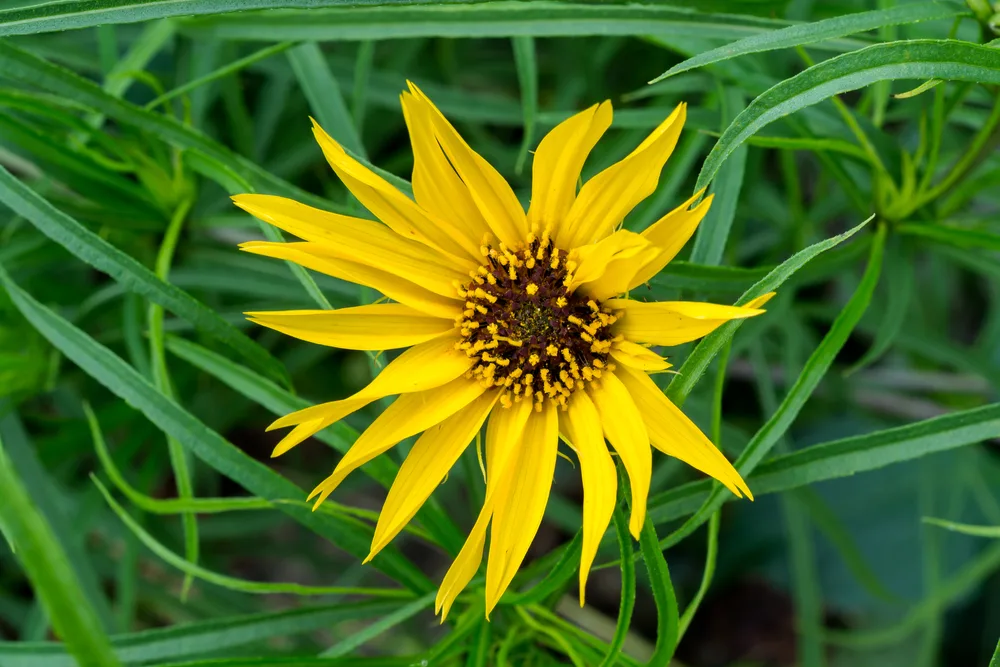
Maximilian sunflower is a tall and glorious late-blooming perennial native to the Great Plains.
It has a large footprint in the garden, growing anywhere from 3 to 10 feet tall with a 4 foot spread – so give this one plenty of room to grow.
Once it reaches epic proportions, Maximilian sunflowers pop off later in the season with a multitude of brilliant yellow flowers, each 2 to 3 inches in size. Like all good sunflowers, its yellow rays are densely packed around the darker center disk.
As one of the last flowers to bloom before the close of the season, Maximilian sunflower provides a good source of nectar for bees and hover flies all the way to autumn.
Hardiness zone: 4 to 9
Sunlight exposure: Full sun
Bloom time: August to September
6. Wild Mock Orange (Philadelphus lewisii)
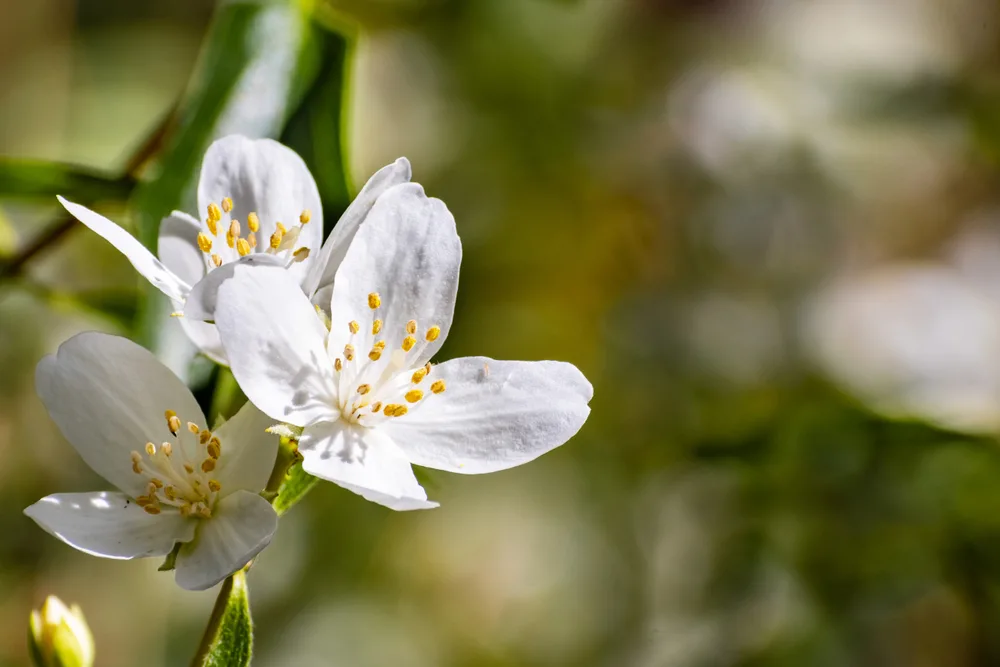
Wild mock orange is a loosely branched, multi-stemmed shrub that’s at its most magnificent in late spring.
On graceful, arching stems, it produces masses of simple white flowers. These 2-inch blossoms have four slightly cupped petals with a smattering of yellow stamens in the center.
Its sweet and citrusy fragrance – like orange with a touch of pineapple – is a pollinator magnet. Hover flies, alongside bees and butterflies, will not be able to resist its delicious aroma.
Hardiness zone: 4 to 9
Sunlight exposure: Full sun to part shade
Bloom time: May to June
7. Common Yarrow (Achillea millefolium)
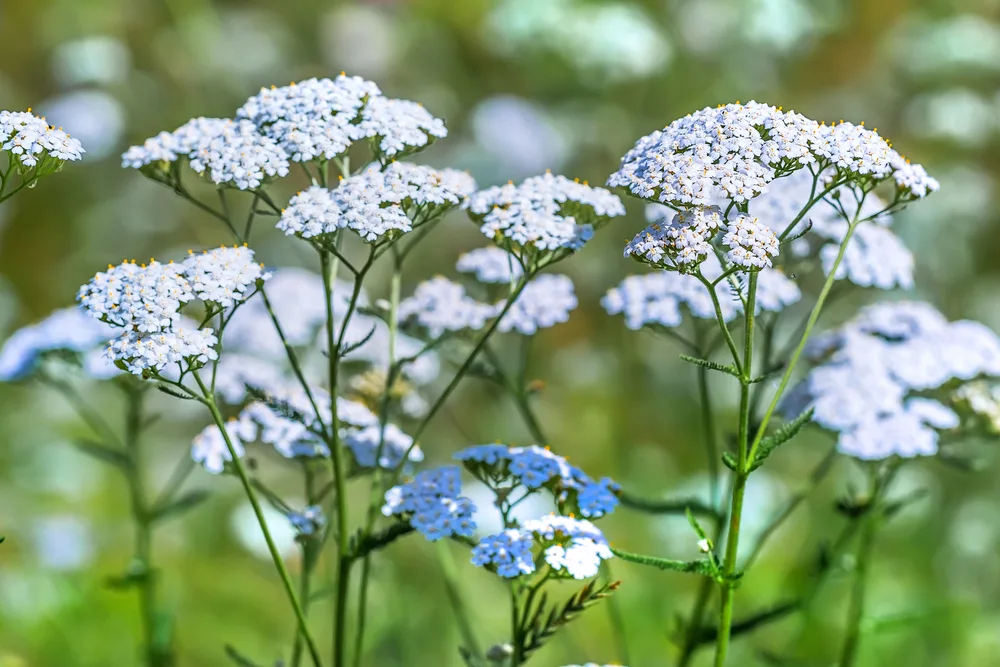
An absolute must for pollinator gardens, common yarrow is an easygoing wildflower that stays in bloom throughout summer.
Common yarrow bears large white flower heads that are 5-inches across. The flat-topped corymbs are tightly packed with teeny flowers that emit a pleasant smell.
Though the standard species produces pretty white umbels, there are dozens of colorful cultivars that flower in a range of yellow, orange, red, pink, and purple hues.
Hardiness zone: 3 to 9
Sunlight exposure: Full sun
Bloom time: June to September
8. Great Blanket Flower (Gaillardia aristata)
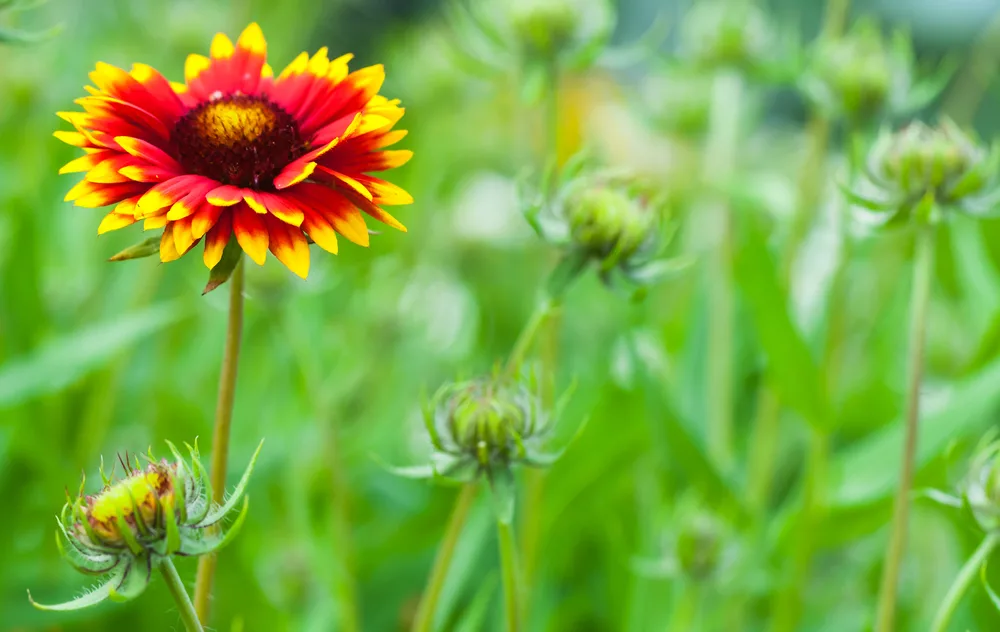
Great blanket flower is a fiery-hued and long blooming perennial that loves a good sunny meadow.
So named for its habit of spreading over the landscape, great blanket flower produces an abundance of 3-inch sunflowers, mostly deep red with golden yellow tips.
The flower’s center is prominently rounded and is an abundant source of nectar. The open blooms are a fantastic safe harbor for hover flies, bees and butterflies to drink and rest.
Hardiness zone: 3 to 8
Sunlight exposure: Full sun
Bloom time: June to September
9. Black-Eyed Susan (Rudbeckia hirta)
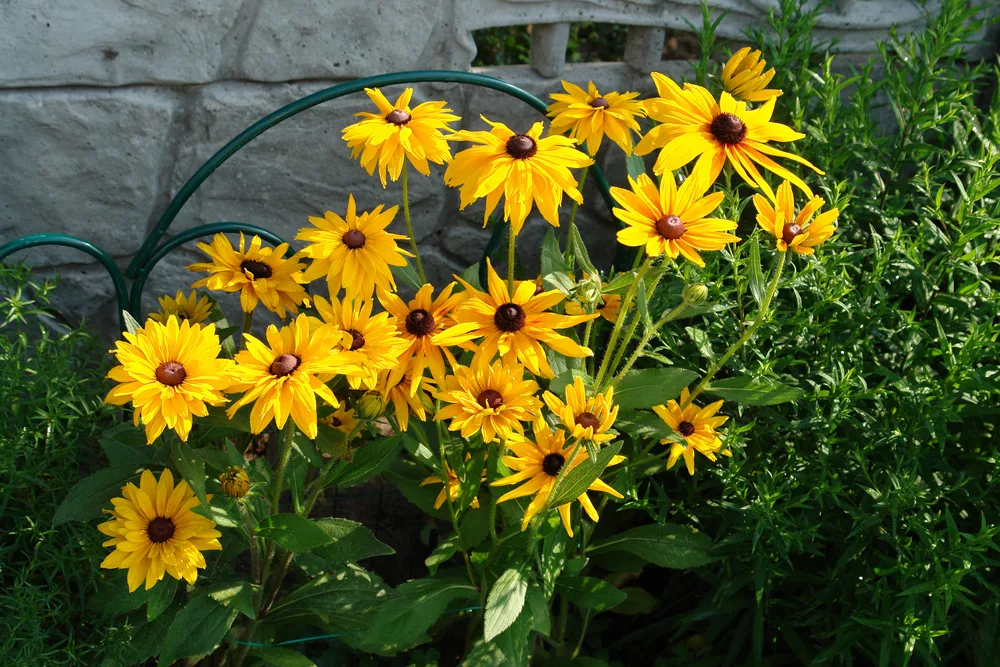
Black-eyed Susan is a time-honored wildflower, so carefree that it flourishes in all 48 contiguous US states.
The daisy-like flower heads, each 3-inches wide, rise up in early summer on stiff 3-foot stems. Slender yellow petals are arrayed around the deep brown (almost black) floral disk.
Black-eyed Susan is definitely a friend of the pollinators and its long blooming period will keep hover flies, bees, wasps and butterflies in nectar country.
Hardiness zone: 3 to 7
Sunlight exposure: Full sun
Bloom time: June to September
10. Sneezeweed (Helenium autumnale)
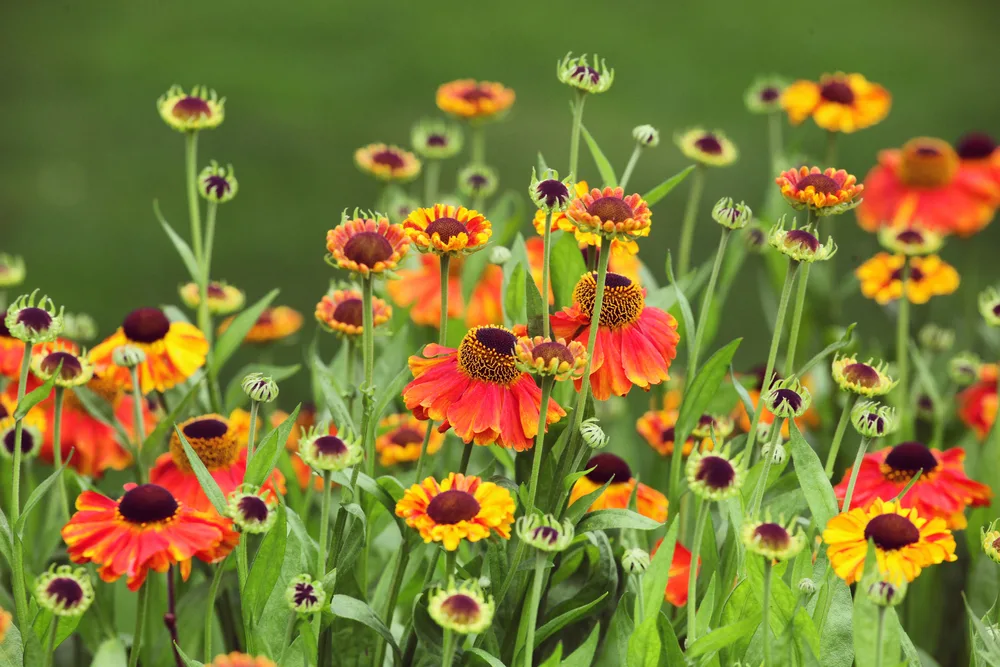
As other blooms are starting to fade, sneezeweed springs to life with charming flowers that usually endure until first frost.
Sneezeweed bears clusters of happy little 2-inch flowers atop erect stems 3 to 5 feet tall. The golden yellow petals are wedge-shaped and tightly gathered around the huge, almost completely spherical center disk.
The disk flowers provide loads of nectar to many types of pollinators, including the hover fly.
And not to worry – being in the proximity of sneezeweed won’t make you sneeze. This plant owes its common name to the ancient practice of grinding up the disk flowers to make snuff in order to sneeze out evil spirits.
Hardiness zone: 3 to 8
Sunlight exposure: Full sun
Bloom time: August to October

Get the famous Rural Sprout newsletter delivered to your inbox.
Including Sunday musings from our editor, Tracey, as well as “What’s Up Wednesday” our roundup of what’s in season and new article updates and alerts.

